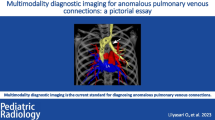Abstract
Pulmonary venous anomalies comprise a wide spectrum of anatomical variations and their clinical presentations may vary from the relatively benign single partial anomalous pulmonary venous connection (PAPVC) to the critical obstructed total anomalous pulmonary venous connection (TAPVC). We briefly review the common anomalies encountered, while highlighting the utility that computed tomographic angiography (CTA) provides for this spectrum of extracardiac vascular malformations and connections. CTA has established itself as an invaluable imaging modality in these patients. A detailed knowledge of the CTA imaging findings in pulmonary venous anomalies is crucial to guide clinical decision-making in these patients.











Similar content being viewed by others
References
Geva T, van Praagh S (2008) Anomalies of the pulmonary veins. In: Allen H, Shaddy R, Driscoll D et al (eds) Moss and Adams’ heart disease in infants, children, and adolescents: including the fetus and young adult, 7th edn. Lippincott Williams & Wilkins, Philadelphia, p 761
Rajiah P, Kanne JP (2010) Computed tomography of pulmonary venous variants and anomalies. J Cardiovasc Comput Tomogr 4:155–163
Latson LA, Prieto LR (2007) Congenital and acquired pulmonary vein stenosis. Circulation 115:103–108
Watson TG, Mah E, Joseph Schoepf U et al (2013) Effective radiation dose in computed tomographic angiography of the chest and diagnostic cardiac catheterization in pediatric patients. Pediatr Cardiol 34:518–524
Nie P, Wang X, Cheng Z et al (2012) Accuracy, image quality and radiation dose comparison of high-pitch spiral and sequential acquisition on 128-slice dual-source CT angiography in children with congenital heart disease. Eur Radiol 22:2057–2066
Karamlou T, Gurofsky R, Al Sukhni E et al (2007) Factors associated with mortality and reoperation in 377 children with total anomalous pulmonary venous connection. Circulation 115:1591–1598
Patton WL, Momenah T, Gooding CA et al (1999) The vascular vise causing TAPVR type I to radiographically mimic TAPVR type III. Pediatr Radiol 29:323–326
Dillman JR, Yarram SG, Hernandez RJ (2009) Imaging of pulmonary venous developmental anomalies. AJR Am J Roentgenol 192:1272–1285
Seale AN, Uemura H, Webber SA et al (2010) Total anomalous pulmonary venous connection: morphology and outcome from an international population-based study. Circulation 122:2718–2726
Cetin I, Ozkan S, Varan B et al (2009) Anomalous pulmonary venous connection to the azygous vein: surgical approach of a case with 3D computed tomography findings. J Card Surg 24:345–347
Tajik AJ, Gau GT, Ritter DG et al (1972) Echocardiographic pattern of right ventricular diastolic volume overload in children. Circulation 46:36–43
Tsitouridis I, Tsinoglou K, Morichovitou A et al (2006) Scimitar syndrome versus meandering pulmonary vein: evaluation with three-dimensional computed tomography. Acta Radiol 47:927–932
Ciliberti P, Taylor AM, Yates R et al (2013) Occlusion of persistent levoatrial cardinal vein without left heart hypoplasia utilizing an Amplatzer device. Eur Heart J Cardiovasc Imaging 14:857
Butts RJ, Crean AM, Hlavacek AM et al (2011) Veno-venous bridges: the forerunners of the sinus venosus defect. Cardiol Young 21:623–630
Seale AN, Webber SA, Uemura H et al (2009) Pulmonary vein stenosis: the UK, Ireland and Sweden collaborative study. Heart 95:1944–1949
Breinholt JP, Hawkins JA, Minich LA et al (1999) Pulmonary vein stenosis with normal connection: associated cardiac abnormalities and variable outcome. Ann Thorac Surg 68:164–168
Frazier AA, Burke AP (2012) The imaging of pulmonary hypertension. Semin Ultrasound CT MR 33:535–551
Conflicts of interest
U. J. Schoepf is a consultant for and receives research support from Bayer, Bracco, GE, Medrad and Siemens. K. Dyer, A. Hlavacek, F. Meinel, C. De Cecco, A. McQuiston and N. Pietris have no disclosures.
Author information
Authors and Affiliations
Corresponding author
Additional information
CME activity This article has been selected as the CME activity for the current month. Please visit the SPR Web site at www.pedrad.org on the Education page and follow the instructions to complete this CME activity.
Rights and permissions
About this article
Cite this article
Dyer, K.T., Hlavacek, A.M., Meinel, F.G. et al. Imaging in congenital pulmonary vein anomalies: the role of computed tomography. Pediatr Radiol 44, 1158–1168 (2014). https://doi.org/10.1007/s00247-014-3044-7
Received:
Revised:
Accepted:
Published:
Issue Date:
DOI: https://doi.org/10.1007/s00247-014-3044-7




